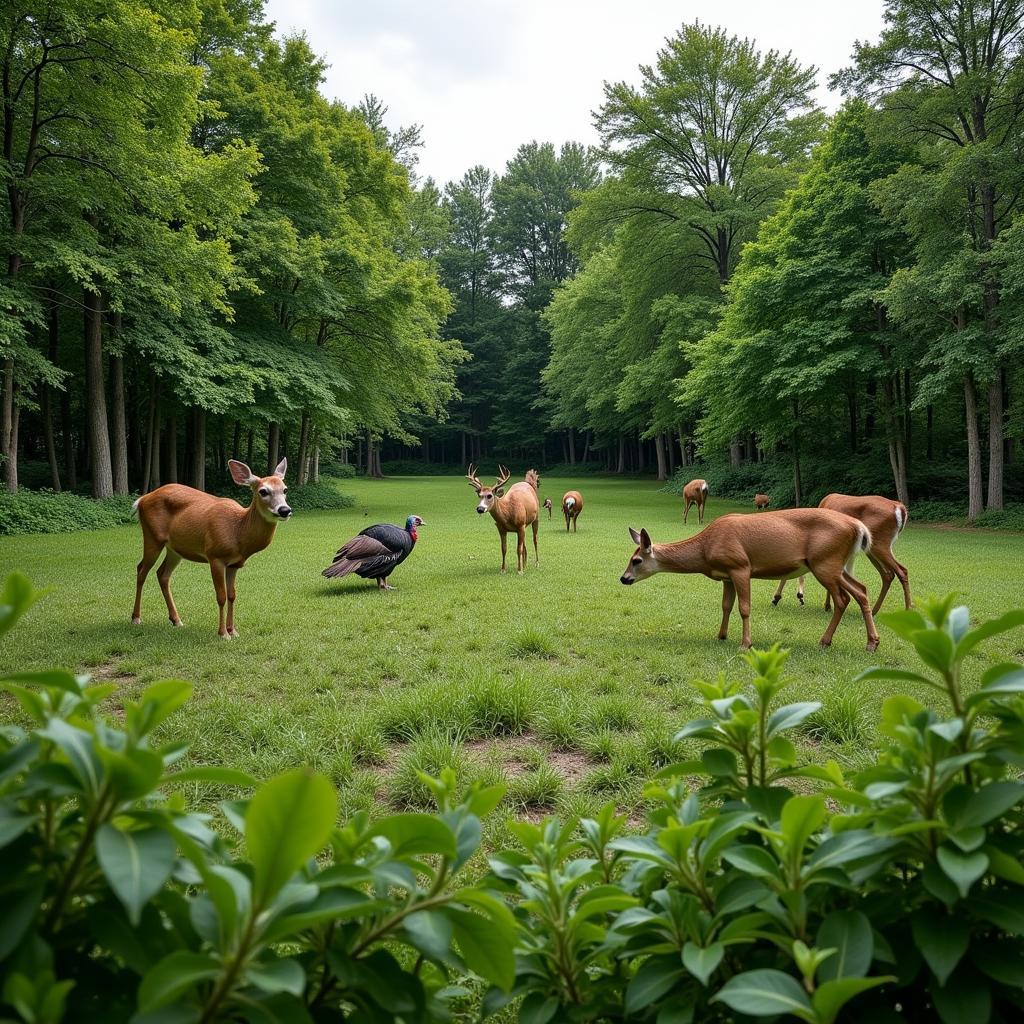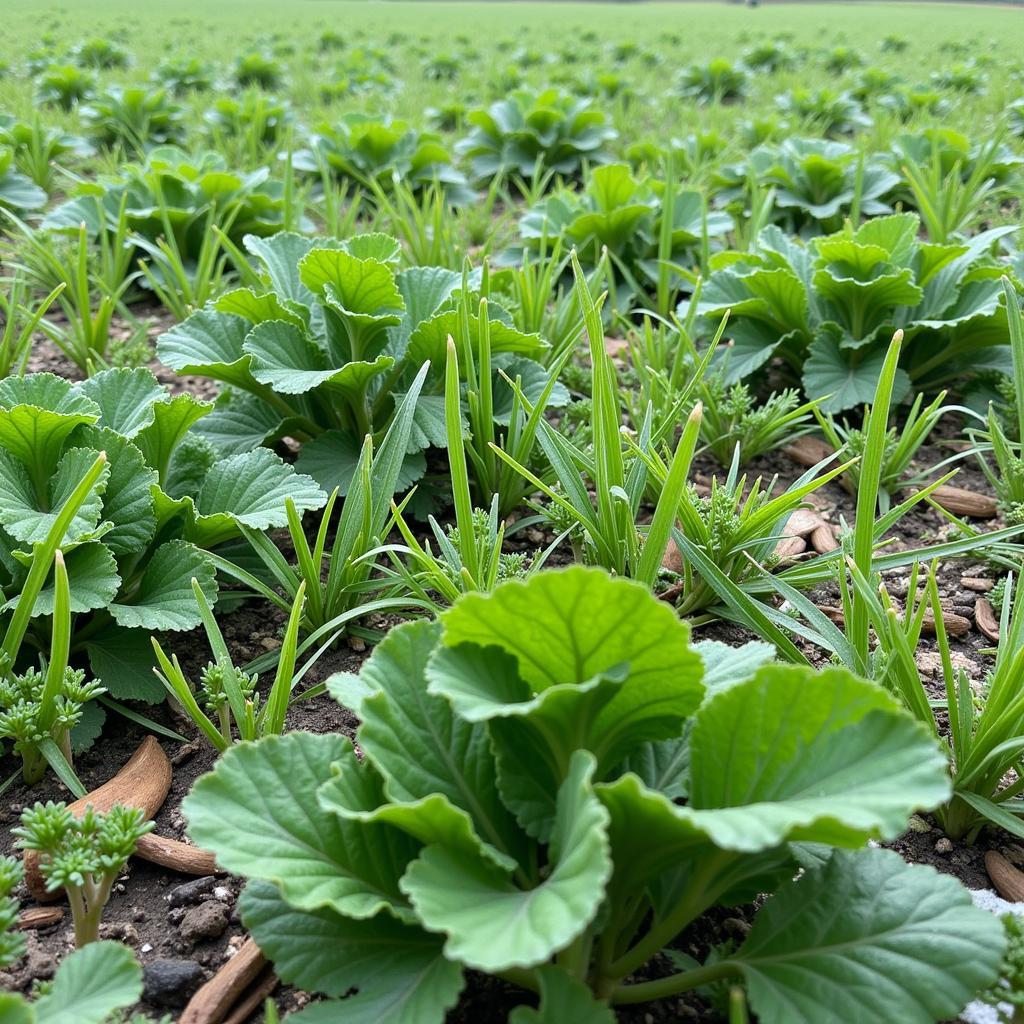Choosing the Best Deer And Turkey Food Plots for your land can be the difference between a thriving wildlife population and a scarce one. Providing these animals with a readily available and nutritious food source not only benefits them but also brings the joy of observing these creatures right to your backyard.
 Deer and Turkey Feeding in a Food Plot
Deer and Turkey Feeding in a Food Plot
Understanding the Basics of Food Plots
Before diving into specific plant varieties, it’s crucial to understand the fundamental principles behind successful deer and turkey food plots. These animals have different nutritional needs throughout the year, so planting a variety of species that mature at different times is essential.
Consider these factors when planning your food plots:
- Soil type and pH: Conduct a soil test to determine the pH and nutrient composition of your soil. This information will help you choose suitable plant species and determine if soil amendments are necessary.
- Sunlight exposure: Different plants have varying sunlight requirements. Observe your plot location throughout the day to determine how many hours of direct sunlight it receives.
- Water availability: While some plants are drought-tolerant, others thrive in moist environments. Assess your area’s average rainfall and consider installing irrigation if necessary.
Choosing the Best Plants for Deer and Turkey Food Plots
The ideal food plot incorporates a mix of plants that provide nutrition throughout the year. Here are some top choices:
Fall and Winter Food Sources:
- Winter Rye: A cold-hardy grain that provides excellent forage during the colder months when other food sources are scarce.
- Brassicas: This group includes turnips, radishes, and kale, which offer high nutritional value and are particularly attractive to deer in late fall and winter.
- Clover: A highly palatable and nutritious legume that can withstand heavy grazing pressure and provides forage from spring to fall.
 Winter Rye and Brassicas in a Food Plot
Winter Rye and Brassicas in a Food Plot
Spring and Summer Food Sources:
- Soybeans: A warm-season legume that provides high protein content, essential for antler growth in deer and egg production in turkeys.
- Cowpeas: Another warm-season legume, cowpeas offer high protein and are very attractive to both deer and turkeys.
- Corn: A popular choice for its high carbohydrate content, providing deer and turkeys with much-needed energy.
Year-Round Options:
- Chicory: A perennial herb with deep roots that can tolerate drought conditions and provide forage year-round.
- Alfalfa: A highly nutritious legume that can provide forage for several years if managed properly.
Maintaining Your Food Plots for Optimal Results
Creating a successful food plot extends beyond just planting the seeds. Proper maintenance is crucial for long-term success:
- Soil testing and amendments: Conduct annual soil tests and amend accordingly to ensure your soil remains fertile and supports healthy plant growth.
- Weed control: Regularly inspect your food plots for weeds and implement appropriate control measures, such as mowing or herbicides, to prevent them from outcompeting your desired plants.
- Fertilization: Follow recommended fertilization schedules based on your soil test results and plant requirements to ensure optimal nutrient availability.
- Rotation: Rotating your food plot locations every few years can help prevent soil depletion and disease buildup.
Tips for Choosing the Right Food Plot Location:
- Proximity to cover: Deer and turkeys prefer areas with nearby cover, such as forests or dense brush, where they can feel secure while feeding.
- Water source: Locate your food plots near a water source, like a pond or stream, as these animals require regular access to water.
- Sunlight and drainage: Choose a site that receives ample sunlight throughout the day and has good drainage to prevent waterlogging.
- Accessibility for planting and maintenance: Ensure your chosen location is accessible for planting, fertilizing, and other maintenance activities.
Frequently Asked Questions about Deer and Turkey Food Plots:
Q: How large should my food plot be?
A: The ideal size depends on your property size and the local deer and turkey population. Start with a smaller plot, around 1/4 to 1/2 acre, and gradually increase the size if needed.
Q: When is the best time to plant my food plot?
A: The optimal planting time varies depending on the plant species and your region’s climate. Refer to seed packet instructions and consult local agricultural resources for specific guidance.
Q: How often should I fertilize my food plot?
A: Fertilization frequency depends on your soil test results and the specific fertilizer you choose. Conduct annual soil tests and adjust your fertilization schedule accordingly.
Q: How can I prevent deer from overgrazing my food plot?
A: Planting a sufficiently large plot, using deer-resistant plant varieties, and implementing rotational grazing practices can help minimize overgrazing.
Need More Help with Your Food Plot Journey?
For personalized advice on creating the best deer and turkey food plots for your specific needs, contact our team at Mina Cones Food. We’re here to help you create a thriving wildlife habitat on your land!
Phone: 02437655121
Email: minacones@gmail.com
Address: 3PGH+8R9, ĐT70A, thôn Trung, Bắc Từ Liêm, Hà Nội, Việt Nam
Explore our website for more information on food plots in sandy soil, winter food plot seed, and the innovative 7 card stud food plot review. We also offer insights into essential tools like the food plot tiller for efficient plot management.
Let Mina Cones Food be your trusted partner in creating a haven for deer and turkey on your property.